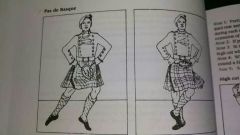![]()
![]()
![]()
Use LEFT and RIGHT arrow keys to navigate between flashcards;
Use UP and DOWN arrow keys to flip the card;
H to show hint;
A reads text to speech;
6 Cards in this Set
- Front
- Back
|
Brush-Outwards |
The half point of the working foot lightly touches the ground I it's progress from this aerial very low through third to an open aerial position or from a rear position, through first position to fourth aerial position. When an outward brush is executed in conjunction with a spring or a hop, the working foot touches the ground almost simultaneously on landing. |
|
|
Brush-Inwards |
The half point of the working foot lightly touches the ground in its progress from an open aerial position to an accepted closed position or to third aerial position low. |
|

Pas de Basque |
Preparing with an extension of the working foot to second aerial position low; spring to that side , bringing the new working foot to third or fifth position, placing it on the half point, then beat (without exaggeration) the ball of the other foot in third or fifth rear position , at the same time sharply extending the front foot, if required, to begin the next movement. Note 1: the same position third or fifth, must be used throughout the movement. Note 2: when a turn, or part of a turn, is executed using two Pas de Basque, there is no extension to finish the first Pas de Basque, and the second is danced with little or no travel. Note 3: this movement may also be danced with other than lateral travel, in which case the extension of the starting foot is along the required line of travel, generally towards fourth intermediate position. Counting: (2 Pas de Basque) swords- 1& 2 3& 4; all other dances- 1 & 2 3 & 4 |
|
|
Open Pas de Basque |
As in Pas de Basque, except that the front foot is placed on fourth-opposite-fifth position and there is no extension at the finish. This movement is used only in the Sword Dance, and on the quick steps is also executed using gas fourth position, fourth intermediate position and second position. |
|
|
Toe-and-heel |
How or spring and , simultaneously on landing, point the working foot on a specified position, then how and, simultaneously on landing, place the heel of the working foot in the same specified position. This movement occupies two beats of music. Note 1: the toe and the heel must touch the ground lightly and the working foot must be kept fairly low. Note 2: the specified position of this movement may be second, third, fourth-opposite-fifth or fifth. The 90° turn out required for the working foot in second position should also be aimed for in the other three positions. |
|
|
Back-step |
Starting with one foot in third aerial position, execute a round-the-leg movement to third rear aerial position, and, with a spring, slide down the back of the supporting leg, bringing the other foot quickly to third aerial position. Repeat as required. This movement may also be executed starting or finishing in third rear aerial position. Each back-step occupies one beat of music. |

